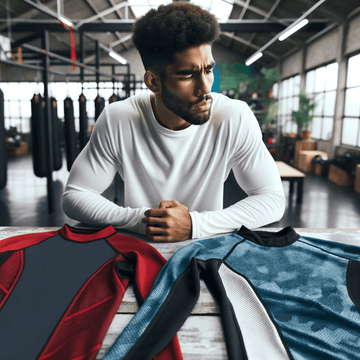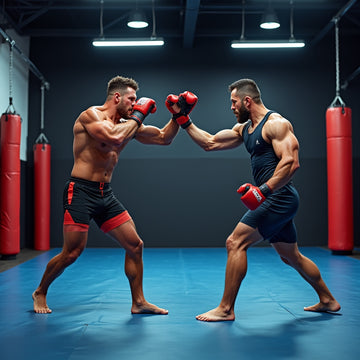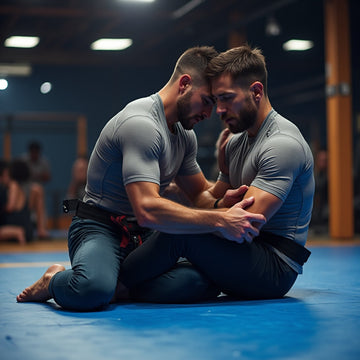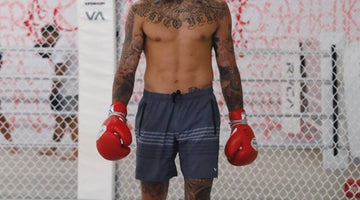Choosing between a short sleeve rash guard and a long sleeve rash guard can feel like a gear gauntlet. Let’s break down the essentials so you know exactly which rash guard is best for MMA training sessions.
Introduction
Here’s the thing: picking the best rash guard for MMA isn’t just about slapping on any top that looks cool. It’s a blend of function, comfort, and protection. Whether you lean toward the freedom of a short sleeve rash guard or the coverage of a long sleeve rash guard, understanding the differences will help you train harder, smarter, and safer.
We’ll chat about which rash guard is best for grappling in our grappling guide, compare no gi rash guard vs with gi scenarios in a dedicated breakdown, and even cover how a shirt can influence sweat control and sun protection. Ready?
What Are Rash Guards?
Ever wondered why fighters wear these slick tops? Rash guards started as a surf accessory to prevent board rash—hence the name. Today, they’re engineered compression shirts, designed to protect your skin from mat burns and keep things hygienic in no-gi training.
Beyond the basic layer, modern MMA rash guards offer sweat-wicking properties and UPF sun protection. Most use a blend of polyester and spandex—light, stretchy, quick to dry. That combo equalizes temperature, so you don’t overheat or feel like you’re wearing a sauna suit.
Benefits of Short Sleeve Rash Guards
Short sleeve rash guard pros cons often come down to freedom of movement versus coverage. A shorter cut means less restriction around the elbow joint, so you can grapple or strike without fabric tugging at your bicep. They’re perfect for hot, sticky gyms, where a full sleeve can feel stifling.
- Mobility: Unhindered arm swings and grip transitions.
- Breathability: Better airflow around the arms and underarms.
- Versatility: Doubles as a base layer under gloves or a standalone top.
On the flip side, less coverage means more skin exposure to mat abrasions or accidental scratches. If you train outdoors or spar with someone’s rough gi, that bare forearm might pay the price.
Benefits of Long Sleeve Rash Guards
Long sleeve rash guard advantages hinge on full-coverage protection. Covering the arms minimizes mat burns and wards off bacterial contact. Plus, a long sleeve rash guard is often the best choice for chillier dojos or air-conditioned gyms where extra warmth is a bonus.
Many fighters swear by MMA rash guard long sleeve benefits such as improved muscle support along the arms and shoulders, which can help with recovery post-sessions. And if you’re training outside, the sleeves double as sun-blocking layers with UPF ratings in some models.
However, too-tight sleeves can feel overbearing to those who prefer an unrestricted range of motion. If you’re a speed demon punching combos on the Thai pads, a long sleeve shirt might seem like an anchor.
Key Differences Between Short and Long Sleeve
When you put side by side short sleeve vs long sleeve rash guard, a few distinctions stand out. Think protection vs freedom, warmth vs airflow, and muscle support vs minimal coverage. Your choice depends on training style, climate, and personal preference.
| Feature | Short Sleeve Rash Guard | Long Sleeve Rash Guard |
|---|---|---|
| Coverage | Shoulder to mid-bicep | Shoulder to wrist |
| Mobility | High | Moderate |
| Temperature Control | Cooler | Warmer |
| Sun Protection | Minimal | Maximum (UPF-rated options) |
| Skin Protection | Limited to biceps | Full arm coverage |
How to Choose Based on Workout Type
How to choose a rash guard for MMA depends on your session. Are you on the mat grappling all day? Fewer scrapes when someone’s kneecap slides across the forearm often mean long sleeves are the way to go. If you’re focusing on striking drills or circuit training, a short sleeve rash guard offers lighter weight and more airflow.
Also consider whether you’ll don a gi. No gi rash guard vs with gi setups differ: under a gi, short sleeves reduce fabric bunching beneath your sleeves, but long sleeves can act as a second skin barrier, keeping sweat off the gi material and reducing odor over time. For deeper guidance, check our gear selection guide.
Material and Fabric Considerations
Rash guard material difference often revolves around three elements: fabric blend, thickness, and stitching. Look for a mix of polyester and spandex (or elastane) that balances stretch with durability. Some premium models even add nylon for extra toughness.
Thickness matters too. A lightweight 220 GSM fabric is ideal for summer training, whereas a sturdier 280 GSM offers a snugger fit and better muscle compression—great for recovery or longer sparring marathons.
Seam placement and flatlock stitching also play a role. Flat seams sit flush against your skin to reduce chafing. Get the full breakdown in our fabric comparison.
Fit and Sizing Guidelines
Rash guard sizing guide tip: these shirts should fit like a second skin, not a billowy T-shirt or a compression tourniquet. For most brands, you’ll see a size chart listing chest and waist measurements—always measure before you buy.
If you’re debating between sizes, err on the smaller side if you want that tight compression fit. If you prefer a bit more breathing room, move up one size. Be mindful that materials break in after a few washes, so you won’t get a drastically looser fit over time.
Maintenance and Care Tips
A rash guard sweat control plan is only as good as your maintenance routine. After training, rinse your shirt in cold water to flush out salt and bacteria. Machine-wash on a gentle cycle, inside out, with similar colors. Avoid high heat—hang dry whenever possible.
For stain removal, pre-treat with a mild enzyme-based cleaner. Fabric softeners are a no-go; they leave a residue that blocks wicking properties. If you want to keep the colors punchy, turn your gear inside out during the spin cycle.
- Rinse immediately after use to avoid odor buildup.
- Use pH-neutral detergent for delicate fabrics.
- Avoid bleach and fabric softener—both degrade fibers.
- Hang dry in shade to preserve UPF coating and graphics.
Discover more in our care guide.
Expert Recommendations & Product Picks
After testing dozens of options, we’ve lined up three standout picks that cater to different needs:
- Against All Gods Rash Guard – midweight with stellar sweat management and grip padding at the forearms.
- Angel of Death Rash Guard – a short sleeve powerhouse designed for striking sessions, with reinforced stitching around high-stress zones.
- Archangel Michael Rash Guard – a long sleeve compression hero with built-in muscle support and UPF 50+ sun protection.
Whether you choose short sleeve or long sleeve, the right rash guard elevates your training by protecting your skin, regulating sweat, and supporting your muscles. Pick the style that suits your regimen and climate, and you’ll have a reliable layer for every MMA challenge.
Updated: 08-18-2025

